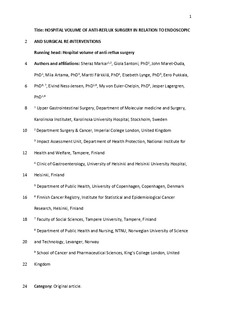Hospital Volume of Antireflux Surgery in Relation to Endoscopic and Surgical Re-interventions
Markar, Sheraz; Santoni, Giola; Maret-Ouda, John; Artama, Miia; Färkkilä, Martti; Lynge, Elsebeth; Pukkala, Eero; Ness-Jensen, Eivind; von Euler-Chelpin, My; Lagergren, Jesper
Journal article, Peer reviewed
Accepted version

Åpne
Permanent lenke
http://hdl.handle.net/11250/2641555Utgivelsesdato
2020Metadata
Vis full innførselSamlinger
Originalversjon
10.1097/SLA.0000000000003776Sammendrag
Objective:
To test the hypothesis that higher hospital volume decreases endoscopic and surgical re-intervention rates after antireflux surgery.
Background:
Antireflux surgery for gastro-esophageal reflux disease is followed by varying rates of re-interventions. Whether hospital volume influences re-intervention rates is uncertain.
Methods:
This population-based cohort study used nationwide data from Denmark, Finland, and Sweden for patients having undergone primary antireflux surgery. Hospitals were divided into tertiles based upon annual volume, that is, 3 equal-sized groups. The outcomes were 30-day surgical re-intervention, endoscopic re-intervention, and secondary antireflux surgery. Multivariable Cox regression provided hazard ratios (HRs) with 95% confidence intervals (CIs) for risk of the first outcome occurrence. Incidence rate ratios were calculated to count all outcome occurrences. All risk estimates were adjusted for age, sex, comorbidity, type of antireflux surgery, year of surgery, and country.
Results:
Among 33,060 patients and a median follow-up of 12 years after antireflux surgery, the frequencies of 30-day re-intervention, endoscopic re-intervention, and secondary antireflux surgery were 1.2%, 4.6%, and 7.0%, respectively. When comparing the highest with the lowest tertiles, higher hospital volume did not decrease HRs of 30-day re-intervention (adjusted HR = 1.14, 95% CI 0.73–1.77), endoscopic re-intervention (HR = 1.21, 95% CI 0.96–1.51), or secondary antireflux surgery (HR = 1.28, 95% CI 1.05–1.54), but rather increased point estimates. The incidence rate ratios showed similar patterns.
Conclusions:
Higher hospital volume of primary antireflux surgery may not decrease risk of endoscopic or surgical re-intervention, suggesting that centralization will not decrease rates of postoperative complications or recurrence of gastro-esophageal reflux disease.